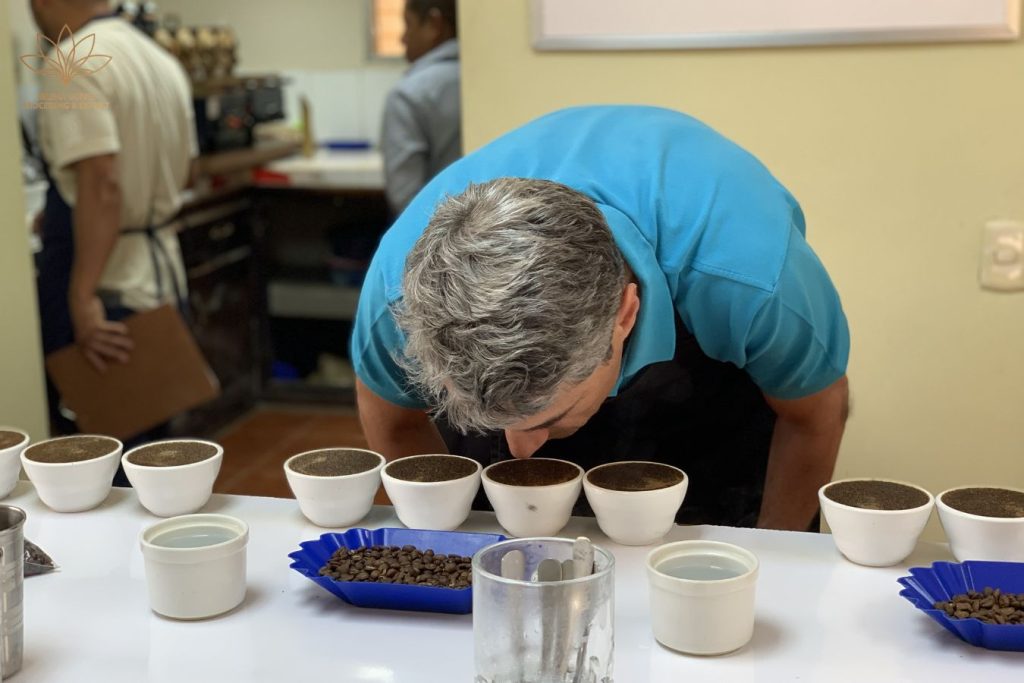Fragrance/Aroma Properties – SCA Cupping Form – This article is part of a group of posts that explain the ten sensory attributes of the SCA Cupping Form (or SCA Arabica Cupping Form) based on knowledge from the book Sensory Science.
For cupping, Fragrance is defined as the smell of ground coffee when it is still dry (before pouring water), and Aroma is described as the smell of coffee when the water has been added during the tasting (wet scent).
“Dry” fragrance and “wet” fragrance
When evaluating fragrance, the first thing a cupper may notice is intensity. This describes the total potency of the scent experience and can be noted on the form, along the corresponding vertical scale of “Dry” – dry fragrance, or “Break” – wet aroma.
Since it is a descriptive attribute (according to sensory science), the intensity of the scent is not scored but will show an impression of quality. Therefore it should be carried out through the following two stages:
- When a cup of ground coffee is prepared on the test table, the cupper will assess the aroma by lifting the lid (if any), gently shaking the ground coffee, noting the intensity of the dry fragrance, and making descriptive notes for any specific attributes or general impressions of quality (Qualities). At the same time, Cupper will evaluate all cups of each prepared coffee sample, as inconsistencies between the cups will indicate any issues related to uniformity.
- Next, thoroughly wet the coffee powder when water at 90-96°C is poured into the cup. A “crust” will be formed on the surface of the cup – consisting of coffee grounds, water, and carbon dioxide; the cups are left to stand for 3-5 minutes. After this time, the copper will repeat the process of smelling and evaluating wet fragrance (Break), as for dry fragrance (Dry).
Scent assessment
Throughout the aroma assessment process, the cupper keeps their nose as close to the coffee as possible (but avoids touching the coffee).
Cupper can smell coffee more than once and need to know that their perception will become less sensitive due to environmental impacts leading to a decrease in the concentration of volatile substances and the adaptation of the sense of smell.
Grading and note notes
Finally, the cupper will score a score on a scale of 6 to 10 points for the “Fragrance/Aroma” attribute, which combines both the impression of dry and wet coffee aromas.
After evaluating Fragrance/Aroma, most coffee grounds will fall to the bottom of the cup, and a small amount of residue remaining on the surface of the cup will be decanted. After that, the cupper can move on to evaluating other properties.
It’s important to note that when cupper starts recording specific scent attributes, they must consider them “Dry” or “Break.” As already mentioned, this tasting phase has the nature of a descriptive test in the department of sensory assessment.
That means you need to focus on recognizing and measuring scent intensity (dry and wet) accurately, indicating that the scent is fruit, honey, chestnut, smoky smell, etc., or anything else – which is not intended to judge quality.
Experts recommend using sensory terms in the SCA’s Coffee Flavor Circle to ease communication between cuppers and because the descriptive data collected at this step may have reference value in the future.
The Coffee Flavor Circle was designed to provide a descriptive term clearly defined at this stage and should not be used in the formal cupping process.
NOTE: We only work in the 6 to 10 range to score each attribute on the cupping form, including Fragrance/Aroma. Why not 5?
Since six is considered “good” and, in other words, it is of above-average quality, if coffee has shown poor quality in any attribute, it is not considered a specialty (Specialty Coffee)
References:
- Primecoffea, Thuộc tính Fragrance/Aroma • SCA Cupping Form, Tháng Một 27, 2023

